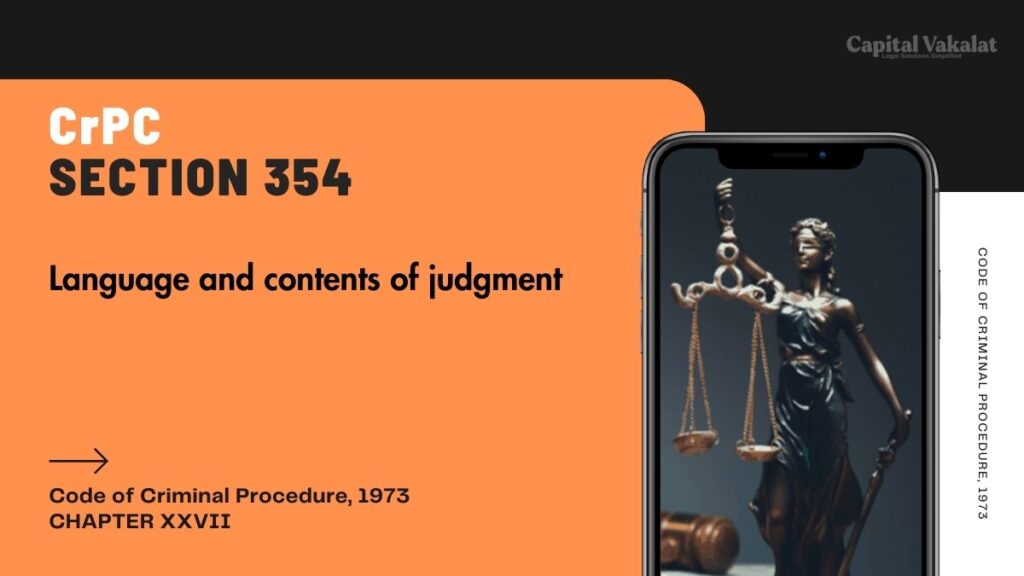The Criminal Procedure Code (CRPC) of India is a comprehensive statute that outlines the procedures for the administration of criminal law in India. Within this vast framework, Section 354 stands out as a critical provision that dictates the language and content of judgments delivered by courts.

The section ensures that judgments are articulated in a manner that upholds clarity, precision, and legal comprehensibility, fostering transparency and accountability within the judiciary.
Historical Context of Section 354 CRPC
The evolution of Section 354 CRPC is rooted in the need for meticulous documentation of judicial decisions. Historically, judgments were often terse and lacked comprehensive explanations, leading to ambiguity and varied interpretations. Recognizing this, legal reforms were introduced to mandate detailed judgments that encapsulate the reasoning behind judicial decisions. These amendments have significantly impacted the quality and transparency of judicial pronouncements, making them more accessible and understandable to the public.
The Purpose of Section 354 CRPC
Section 354 CRPC serves a dual purpose. Primarily, it aims to ensure that judgments are communicated clearly and precisely, thus preventing any misinterpretation. Secondly, detailed judgments serve as crucial references for future cases, helping in the establishment of consistent legal precedents. This section mandates judges to articulate their findings comprehensively, providing a logical and legal basis for their decisions.
Language Requirements Under Section 354 CRPC
The language of a judgment is paramount to its clarity and effectiveness. Section 354 CRPC emphasizes the use of precise and unambiguous language. While legal terminology is necessary, it is equally important to balance it with explanations that are comprehensible to those not well-versed in legal jargon. This approach ensures that judgments are accessible to a broader audience, including the litigants and the public.
Essential Components of a Judgment
A well-structured judgment under Section 354 CRPC typically includes several key components:
- Factual Narration: A detailed account of the facts of the case, presented chronologically to provide a clear background.
- Legal Findings: An analysis of the legal issues involved, referencing relevant laws and precedents.
- Application of Law: How the law is applied to the facts, leading to the final decision or verdict.
Structure of a Judgment
The structure of a judgment is as important as its content. A typical judgment under Section 354 CRPC is organized as follows:
- Heading and Title: Clearly indicating the case number, parties involved, and the court.
- Introduction: Brief overview of the case and the issues at hand.
- Factual Matrix: Detailed presentation of the facts.
- Evidence Analysis: Examination and evaluation of the evidence presented.
- Findings and Conclusion: The judge’s legal reasoning and final decision.
Significance of Detailed Judgments
Detailed judgments play a critical role in the legal system. They provide a transparent record of judicial reasoning, which is essential for maintaining public trust in the judiciary. Moreover, these judgments serve as valuable references for future cases, contributing to the development of consistent legal standards and principles.
Common Pitfalls in Judgment Writing
Despite the guidelines provided by Section 354 CRPC, judgment writing can often fall prey to certain pitfalls:
- Ambiguity and Vagueness: Lack of clarity can lead to varied interpretations.
- Over-reliance on Legal Jargon: Excessive use of technical language can obscure the judgment’s meaning.
Case Study: Analysis of a Landmark Judgment Under Section 354 CRPC
To illustrate the application of Section 354 CRPC, consider a landmark case where the detailed judgment set a significant legal precedent. The background of the case, key points from the judgment, and its impact on subsequent cases highlight the importance of clarity and thoroughness in judicial pronouncements.
Best Practices for Drafting Judgments
Effective judgment drafting requires adherence to best practices, including:
- Use of Plain Language: Ensuring the judgment is understandable to non-legal readers.
- Avoiding Bias and Ensuring Neutrality: Presenting facts and legal reasoning objectively.
- Citing Precedents Accurately: Properly referencing previous cases to support the judgment.
Impact of Technology on Judgment Writing
Technology has revolutionized many aspects of legal practice, including judgment writing. Digital tools facilitate more efficient drafting and review of judgments. Additionally, electronic judgments enhance accessibility, allowing easier public access to judicial decisions.
Judicial Training and Development
Continuous training and development are crucial for judges to maintain and enhance their judgment writing skills. Workshops, seminars, and training programs provide valuable opportunities for judges to stay updated on best practices and emerging trends in legal drafting.
Role of Legal Academics in Enhancing Judgment Quality
Legal academics play a significant role in improving the quality of judgments. Through scholarly articles and research, they provide insights and recommendations that help judges refine their writing. Collaboration between the judiciary and academia fosters a mutually beneficial exchange of knowledge and expertise.
Public Perception of Judicial Judgments
The media plays a pivotal role in shaping public perception of judicial judgments. By accurately reporting and explaining judgments, the media can enhance public understanding and trust in the judiciary. Simplified summaries of judgments also help in making complex legal decisions more accessible to the general public.
Future Trends in Judgment Writing
The future of judgment writing may see the integration of advanced technologies such as artificial intelligence and machine learning. These technologies have the potential to streamline the drafting process and improve the consistency and quality of judgments. Additionally, ongoing legal reforms may introduce new standards and practices for judgment writing, further enhancing the clarity and comprehensiveness of judicial decisions.
Conclusion
Section 354 CRPC is a cornerstone of judicial accountability and transparency in India. By mandating detailed and clear judgments, it ensures that the legal reasoning behind judicial decisions is accessible and understandable. This not only upholds the principles of justice but also strengthens public confidence in the judiciary.